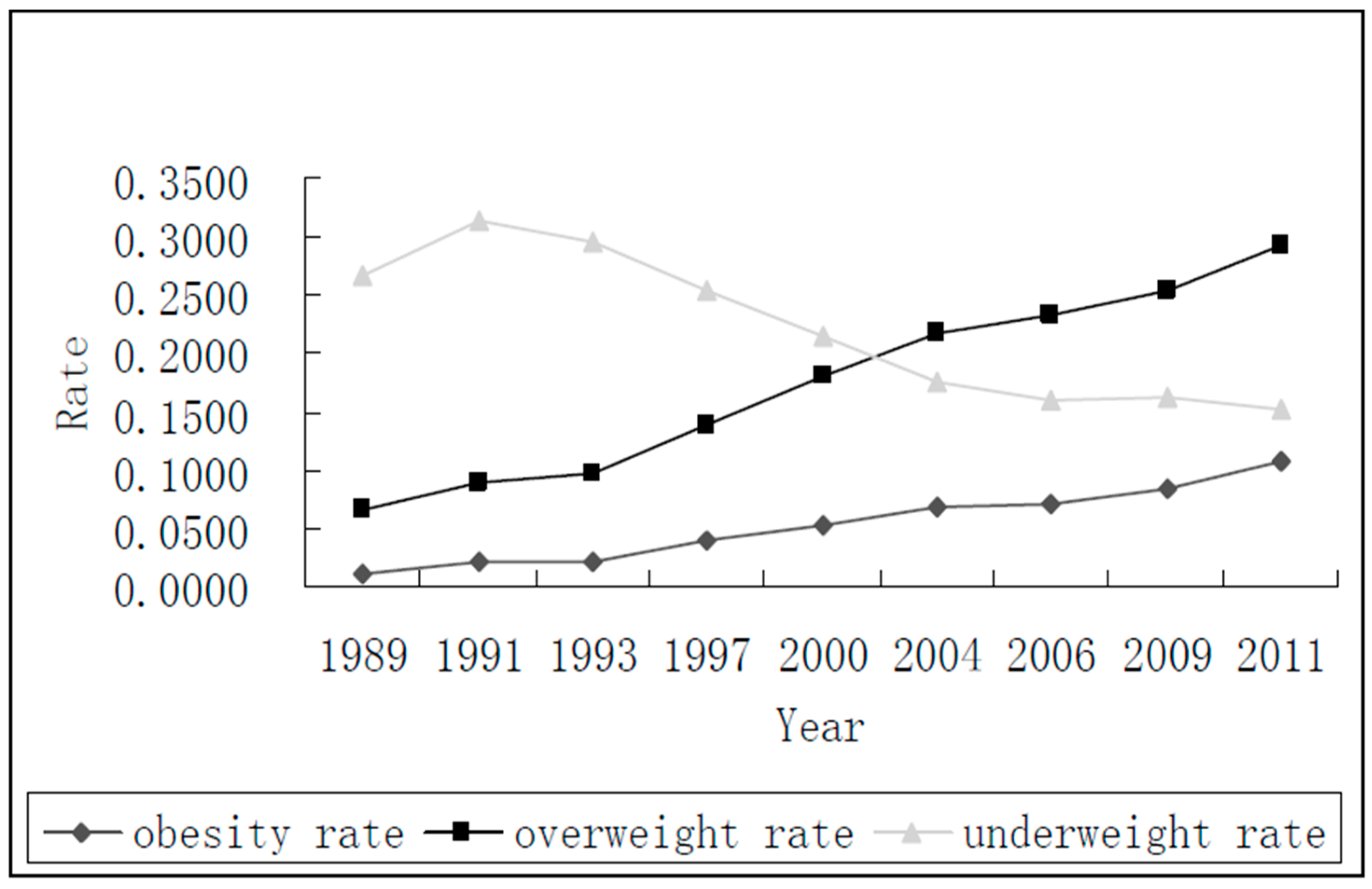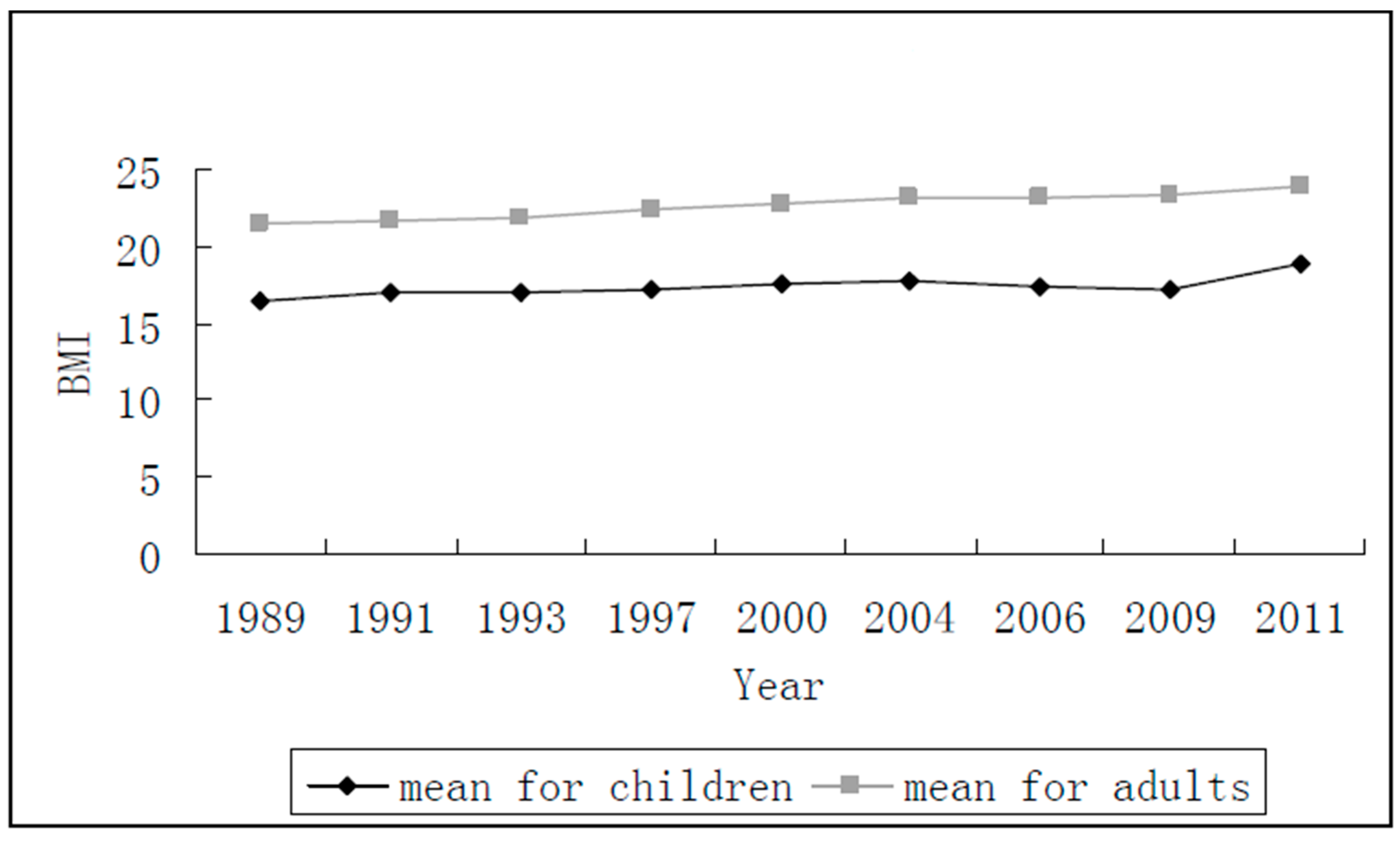Modeling the Effect of Physical Activity on Obesity in China: Evidence from the Longitudinal China Health and Nutrition Study 1989–2011
Abstract
:1. Introduction
2. Materials and Methods
3. Results
3.1. Results of Granger Causality Test for Children
3.2. Results of Longitudinal Regressions for Adults
4. Discussion
5. Conclusions
Conflicts of Interest
References
- Sarma, S.; Zaric, G.S.; Campbell, M.K.; Gilliland, J. The effect of physical activity on adult obesity: Evidence from the Canadian NPHS panel. Econ. Hum. Biol. 2014, 14, 1–21. [Google Scholar] [CrossRef] [PubMed]
- Littman, A.J.; Kristal, A.R.; White, E. Effects of physical activity intensity, frequency, and activity type on 10-y weight change in middle-aged men and women. Int. J. Obes. 2005, 29, 524–533. [Google Scholar] [CrossRef] [PubMed]
- Gordon-Larsen, P.; Hou, N.; Sidney, S.; Sternfeld, B.; Lewis, C.E.; Jacobs, D.R., Jr.; Popkin, B.M. Fifteen-year longitudinal trends in walking patterns and their impact on weight change. Am. J. Clin. Nutr. 2009, 89, 19–26. [Google Scholar] [CrossRef] [PubMed]
- Hankinson, A.L.; Daviglus, M.L.; Bouchard, C.; Carnethon, M.; Lewis, C.E.; Schreiner, P.J.; Liu, K.; Sidney, S. Maintaining a high physical activity level over 20 years and weight gain. J. Am. Med. Assoc. 2010, 304, 2603–2610. [Google Scholar] [CrossRef] [PubMed]
- Ekelund, U.; Besson, H.; Luan, J.; May, A.M.; Sharp, S.J.; Brage, S.; Travier, N.; Agudo, A.; Slimani, N.; Rinaldi, S. Physical activity and gain in abdominal adiposity and body weight: Prospective cohort study in 288,498 men and women. Am. J. Clin. Nutr. 2011, 93, 826–835. [Google Scholar] [CrossRef] [PubMed]
- Williams, P.T. Maintaining vigorous activity attenuates 7-yr weight gain in 8340 runners. Med. Sci. Sports Exerc. 2007, 39, 801–809. [Google Scholar] [CrossRef] [PubMed]
- Summerbell, C.D.; Douthwaite, W.; Whittaker, V.; Ells, L.J.; Hillier, F.; Smith, S.; Kelly, S.; Edmunds, L.D.; Macdonald, I. The association between diet and physical activity and subsequent excess weight gain and obesity assessed at 5 years of age or older: A systematic review of the epidemiological evidence. Int. J. Obes. 2009, 33, S1–S92. [Google Scholar]
- He, X.Z.; Baker, D.W. Changes in weight among a nationally representative cohort of adults aged 51–61, 1992–2000. Am. J. Prev. Med. 2004, 27, 8–15. [Google Scholar] [CrossRef] [PubMed]
- Petersen, L.; Schnohr, P.; Sørensen, T.I.A. Longitudinal study of the long-term relation between physical activity and obesity in adults. Int. J. Obes. 2003, 28, 105–112. [Google Scholar] [CrossRef] [PubMed]
- Dencker, M.; Thorsson, O.; Karlsson, M.K.; Lindén, C.; Eiberg, S.; Wollmer, P.; Andersen, L.B. Daily physical activity related to body fat in children aged 8–11 years. J. Pediatr. 2006, 149, 38–42. [Google Scholar] [CrossRef] [PubMed]
- Ness, A.R.; Leary, S.D.; Mattocks, C.; Blair, S.N.; Reilly, J.J.; Wells, J.; Ingle, S.; Tilling, K.; Smith, G.D.; Riddoch, C. Objectively measured physical activity and fat mass in a large cohort of children. PLoS Med. 2007, 4, e97. [Google Scholar] [CrossRef] [PubMed] [Green Version]
- Tremblay, M.S.; Colley, R.C.; Saunders, T.J.; Healy, G.N.; Owen, N. Physiological and health implications of a sedentary lifestyle. Appl. Phys. Nutr. Metab. 2010, 35, 725–740. [Google Scholar] [CrossRef] [PubMed]
- Jimenez-Pavon, D.; Kelly, J.; Reilly, J.J. Associations between objectively measured habitual physical activity and adiposity in children and adolescents: Systematic review. Int. J. Pediatr. Obes. 2010, 5, 3–18. [Google Scholar] [CrossRef] [PubMed]
- Komlos, J.; Smith, P.K.; Bogin, B. Obesity and the rate of time preference: Is there a connection? J. Biosoc. Sci. 2004, 36, 209–219. [Google Scholar] [CrossRef] [PubMed]
- Smith, P.K.; Bogin, B.; Bishai, D. Are time preference and body mass index associated? Evidence from the National Longitudinal Survey of Youth. Econ. Hum. Biol. 2005, 3, 259–270. [Google Scholar] [CrossRef] [PubMed]
- Hill, A.B. The environment and disease: Association or causation? Proc. R. Soc. Med. 1965, 58, 295–300. [Google Scholar] [CrossRef] [PubMed]
- Zhou, B.F. Predictive values of body mass index and waist circumference for risk factors of certain related diseases in Chinese adults—Study on optimal cut-off points of body mass index and waist circumference in Chinese adults. Biomed. Environ. Sci. 2002, 15, 83–96. [Google Scholar] [PubMed]
- Chou, S.-Y.; Grossman, M.; Saffer, H. An economic analysis of adult obesity: Results from the Behavioral Risk Factor Surveillance System. J. Health Econ. 2004, 23, 565–587. [Google Scholar] [CrossRef] [PubMed]
- Zhang, T. Socioeconomic determinants of obesity and hypertension at the county level in China. Math. Popul. Stud. 2016, 23, 239–252. [Google Scholar] [CrossRef]
- Wooldridge, J.M. Econometric Analysis of Cross Section and Panel Data; The MIT Press: Cambridge, MA, USA, 2002. [Google Scholar]
- Nickell, S. Biases in dynamic models with fixed effects. Econometrica 1981, 49, 1417–1426. [Google Scholar] [CrossRef]
- Arellano, M.; Bond, S. Some tests of specification for panel data: Monte Carlo evidence and an application to employment equations. Rev. Econ. Stud. 1991, 58, 277–297. [Google Scholar] [CrossRef]
- Arellano, M.; Bover, O. Another look at the instrumental variable estimation of error-components models. J. Econom. 1995, 68, 29–51. [Google Scholar] [CrossRef]
- Baltagi, B.H. Econometric Analysis of Panel Data; John Wiley & Sons: Chichester, UK, 2005. [Google Scholar]
- Granger, C.W.J. Investigating Causal Relations by Econometric Models and Cross-Spectral Methods. Econometrica 1969, 37, 424–438. [Google Scholar] [CrossRef]
- Dumitrescu, E.-I.; Hurlin, C. Testing for Granger Non-causality in Heterogeneous Panels. Econ. Model. 2012, 29, 1450–1460. [Google Scholar] [CrossRef]
- Godley, J.; McLaren, L. Socioeconomic status and body mass index in Canada: Exploring measures and mechanisms. Can. Rev. Sociol. 2010, 47, 381–403. [Google Scholar] [CrossRef] [PubMed]
- McLaren, L.; Auld, M.C.; Godley, J.; Still, D.; Gauvin, L. Examining the association between socioeconomic position and body mass index in 1978 and 2005 among Canadian working-age women and men. Int. J. Public Health 2010, 55, 193–200. [Google Scholar] [CrossRef] [PubMed]
- Wolff, H.; Delhumeau, C.; Beer-Borst, S.; Golay, A.; Costanza, M.C.; Morabia, A. Converging prevalences of obesity across educational groups in Switzerland. Obesity 2006, 14, 2080–2088. [Google Scholar] [CrossRef] [PubMed]
- McManus, A.M.; Mellecker, R.R. Physical activity and obese children. J. Sport Health Sci. 2012, 1, 141–148. [Google Scholar] [CrossRef]
- Wareham, N.J.; van Sluijs, E.M.F.; Ekelund, U. Physical activity and obesity prevention: A review of the current evidence. Proc. Nutr. Soc. 2005, 64, 229–247. [Google Scholar] [CrossRef] [PubMed]


| Year | Walking (min) | PA in School (h) | Participating in PA (0/1) | PA Before or after School (min) | Watching TV (min) | Reading or Writing (min) |
|---|---|---|---|---|---|---|
| 1997 | 30.02 | 3.75 | 0.07 | 405.55 | 451.07 | |
| 2000 | 27.17 | 3.04 | 0.34 | 387.41 | 210.38 | |
| 2004 | 37.60 | 3.76 | 0.35 | 54.85 | ||
| 2006 | 39.09 | 5.97 | 0.34 | 50.81 | ||
| 2009 | 37.72 | 5.53 | 0.37 | 52.22 | ||
| 2011 | 40.86 | 6.43 | 0.34 | 58.20 |
| Year | Education | Household Income | PA | Age | Urban/Rural | Gender |
|---|---|---|---|---|---|---|
| 1989 | 6.81 | 4243.57 | 31.46 | 0.69 | 0.51 | |
| 1991 | 5.22 | 4411.37 | 41.18 | 0.67 | 0.51 | |
| 1993 | 6.03 | 6174.58 | 42.09 | 0.69 | 0.51 | |
| 1997 | 6.23 | 11,754.65 | 890.99 | 43.58 | 0.65 | 0.50 |
| 2000 | 7.54 | 14,180.95 | 811.01 | 44.99 | 0.66 | 0.51 |
| 2004 | 8.71 | 18,288.92 | 1050.15 | 48.02 | 0.65 | 0.51 |
| 2006 | 8.58 | 21,801.42 | 996.72 | 49.27 | 0.66 | 0.52 |
| 2009 | 8.85 | 35,466.88 | 932.12 | 50.01 | 0.67 | 0.51 |
| 2011 | 9.09 | 44,186.12 | 939.48 | 51.68 | 0.66 | 0.52 |
| Null Hypothesis: | F-Statistic | Prob. |
|---|---|---|
| ‘Participating in PA’ does not cause BMI | 8.5446 *** | 0.0035 |
| BMI does not cause ‘Participating in PA’ | 1.9653 | 0.161 |
| ‘PA in school’ does not cause BMI | 2.1007 | 0.1473 |
| BMI does not cause ‘PA in school’ | 0.1818 | 0.6699 |
| ‘PA before or after school’ does not cause BMI | 9.7411 *** | 0.002 |
| BMI does not cause ‘PA before or after school’ | 2.4027 | 0.1225 |
| ‘Reading or writing’ does not cause BMI | 0.9261 | 0.3363 |
| BMI does not cause ‘Reading or writing’ | 0.1201 | 0.7291 |
| ‘Watching TV’ does not cause BMI | 0.4782 | 0.4894 |
| BMI does not cause ‘Watching TV’ | 7.9869 *** | 0.0048 |
| ‘Walking from home to school’ does not cause BMI | 3.5197 ** | 0.0298 |
| BMI does not cause ‘Walking from home to school’ | 0.1766 | 0.8382 |
| Static Fixed Effects Regression | Static Random Effects Regression | Dynamic Panel Regression without the Lagged PA | Dynamic Panel Regression with Equation (1) | |
|---|---|---|---|---|
| Urban/Rural | −0.01633 | −0.06740 | 4.27214 *** | 5.40653 *** |
| Gender | 0.12796 | 0.06986 | 10.44104 *** | 9.94068 *** |
| Education | 0.00498 | 0.04019 *** | 0.00034 | −0.00976 |
| Household income (1000 Yuan) | 0.00057 | 0.00466 *** | 0.00032 | 0.00198 ** |
| Age | 0.10589 *** | 0.05322 *** | 0.03818 *** | 0.03493 *** |
| PA | −0.00002 | −0.00005 *** | −0.00006 *** | −0.00018 ** |
| BMI(t−1) | 0.46047 *** | 0.38019 *** | ||
| PA(t−1) | −0.00034 ** | |||
| PA(t−2) | 0.00005 | |||
| Constant | 18.160 *** | 19.710 *** | −12.149 *** | −10.930 ** |
| Sigma_u | 3.437 | 2.815 | ||
| Sigma_e | 2.001 | 2.001 | ||
| Test of individual effects | F = 5.77 *** | χ2 = 15,806.56 *** | ||
| Wald test for all variables | F = 305.96 *** | χ2 = 1218.46 *** | χ2 = 853.72 *** | χ2 = 734.79 *** |
© 2017 by the author. Licensee MDPI, Basel, Switzerland. This article is an open access article distributed under the terms and conditions of the Creative Commons Attribution (CC BY) license (http://creativecommons.org/licenses/by/4.0/).
Share and Cite
Zhang, T. Modeling the Effect of Physical Activity on Obesity in China: Evidence from the Longitudinal China Health and Nutrition Study 1989–2011. Int. J. Environ. Res. Public Health 2017, 14, 844. https://doi.org/10.3390/ijerph14080844
Zhang T. Modeling the Effect of Physical Activity on Obesity in China: Evidence from the Longitudinal China Health and Nutrition Study 1989–2011. International Journal of Environmental Research and Public Health. 2017; 14(8):844. https://doi.org/10.3390/ijerph14080844
Chicago/Turabian StyleZhang, Tao. 2017. "Modeling the Effect of Physical Activity on Obesity in China: Evidence from the Longitudinal China Health and Nutrition Study 1989–2011" International Journal of Environmental Research and Public Health 14, no. 8: 844. https://doi.org/10.3390/ijerph14080844





